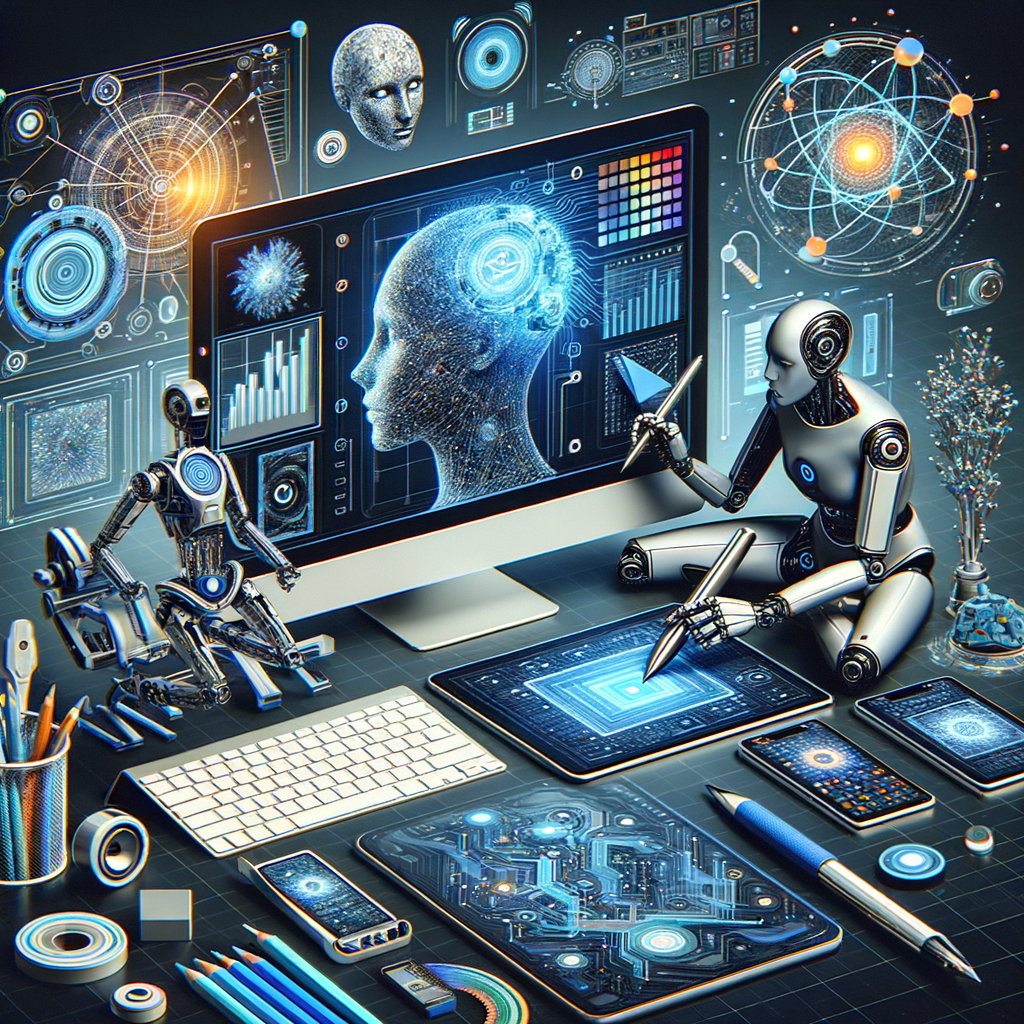
AI-Driven Design Workflow: Effortless And Stunning Results
- Understanding AI-Driven Design
- Key Benefits of AI in Design
- 1. Enhanced Creativity
- 2. Streamlined Workflow
- 3. Data-Driven Decisions
- Common AI Tools in Design
- 1. Adobe Sensei
- 2. Canva
- 3. Figma Plugins
- How to Integrate AI into Your Design Workflow
- Step 1: Identify Your Needs
- Step 2: Research AI Tools
- Step 3: Start Small
- Step 4: Train and Discover
- Step 5: Evaluate and Adapt
- Future Trends in AI-Driven Design
- 1. Increased Personalization
- 2. Voice and Gesture Recognition
- 3. Real-Time Collaboration
- Challenges of AI in Design
- 1. Dependence on Technology
- 2. Data Privacy Concerns
- 3. Cost of Implementation
- Real-Life Success Stories
- Case Study: Nike
- Case Study: The New York Times
- Conclusion: The Way Forward
- FAQs
- References
Understanding AI-Driven Design
Artificial intelligence (AI) transforms how we approach design. Traditionally, designers employed manual techniques to create layouts, graphics, and user experiences. Today, AI simplifies this process. By automating various tasks, AI allows designers to focus more on creativity and strategy. But what exactly does AI offer in the design workflow?
AI-driven design focuses on leveraging algorithms to produce stunning visuals with minimal effort. Imagine having smart tools that learn from prior work and refine their outputs over time. These tools analyze patterns, understand user preferences, and even predict design trends. They help designers create solutions that resonate with users while saving them time and effort.
The integration of AI in design isn’t just a trend. It offers numerous advantages that elevate the design process. From enhancing productivity to delivering high-quality results, let’s explore how AI-driven design can reshape your creative workflow.
Key Benefits of AI in Design
1. Enhanced Creativity
AI tools empower designers to explore innovative concepts. While computers generate suggestions based on data, they do not replace human creativity. Instead, they complement it, offering a fresh perspective. Imagine receiving a design report analyzing trends from your previous projects. With this insight, you can generate unique ideas that may never cross your mind.
Additionally, AI algorithms can recommend color palettes, typography, and layout suggestions tailored to your project goals. Designers can select favorite options, leading to richer and visually appealing outcomes. You can imagine how this tool can inspire even seasoned professionals.
2. Streamlined Workflow
AI automates repetitive tasks that can drain time. For example, resizing images for various platforms can become tedious. AI can streamline this process by adjusting dimensions with a single click. Consequently, you save valuable time for more complex projects.
Furthermore, collaborative tools powered by AI facilitate easier communication among team members. Designers can share feedback, track changes, and collaborate seamlessly. Centralizing everything within one tool enhances efficiency and reduces the chaos of juggling multiple applications.
3. Data-Driven Decisions
Making informed design choices has never been easier. AI systems analyze data to guide your decisions. They evaluate user behaviors, preferences, and interaction statistics to predict what designs will resonate most. As a result, you can craft user-centric designs that meet real needs.
Moreover, A/B testing becomes more effective with AI. You can test variations and let the algorithms determine which performs best. This approach eliminates guesswork and allows you to make strategic choices based on concrete data.
Common AI Tools in Design
1. Adobe Sensei
Adobe Sensei integrates AI into Adobe’s Creative Cloud. It helps enhance images, automate tagging, and suggest design elements. With features like the Content-Aware Fill tool, it allows designers to manipulate images efficiently. This integration provides a seamless experience for users already familiar with Adobe products.
2. Canva
Canva incorporates AI to simplify design for users of all skill levels. Its Magic Resize feature allows you to adapt designs effortlessly for various formats. Additionally, its layout suggestion feature helps you explore different compositions automatically, sparking creativity.
3. Figma Plugins
Figma, a popular design tool, offers numerous AI-driven plugins. These tools can help automate tasks like creating responsive layouts or generating image variations. This flexibility enables designers to maintain their creative freedom while benefiting from automation.
How to Integrate AI into Your Design Workflow
Step 1: Identify Your Needs
Before integrating AI tools, assess your workflow. Identify repetitive tasks that consume your time. Create a list of processes that could be optimized. Whether it’s image resizing or data analysis, knowing where AI can help is crucial.
Step 2: Research AI Tools
Explore different AI tools available in the market. Choose those that align with your objectives and budget. Read user reviews and compare functionalities to select the best fit.
Step 3: Start Small
Rather than overhauling your entire workflow, start with one or two tools. Gradually introduce these solutions into your existing processes. Monitor their performance and gather feedback. This approach minimizes disruption and allows you to adapt smoothly.
Step 4: Train and Discover
Once you’ve integrated AI tools, invest time in training. Familiarize yourself with their capabilities and explore how they can enhance your projects. Many platforms offer tutorials or community forums. Use these resources to maximize the value of your tools.
Step 5: Evaluate and Adapt
Regularly evaluate the impact of AI on your workflow. Are your processes more efficient? Are you producing better designs? Gather feedback from your team to identify areas for improvement. This ongoing evaluation ensures that you stay up-to-date with evolving technology.
Future Trends in AI-Driven Design
1. Increased Personalization
The future of AI in design promises even greater personalization. As algorithms become more sophisticated, they will better understand individual users. This capability will enable hyper-personalized designs that speak directly to the audience’s preferences.
2. Voice and Gesture Recognition
AI will likely take user interaction to new heights. Voice and gesture recognition technologies will pave the way for hands-free control. Designers can create more intuitive interfaces that respond to natural commands and movements.
3. Real-Time Collaboration
Advancements in AI will enable more seamless collaboration among teams. Imagine working with others in real time, regardless of geographical boundaries. AI-powered tools will facilitate live feedback and editing, fostering an environment ripe for creativity.
Challenges of AI in Design
1. Dependence on Technology
Relying too heavily on AI can reduce your creative instincts. Designers may lean on algorithms to make decisions, neglecting the human touch. Balancing technology use with personal creativity becomes crucial.
2. Data Privacy Concerns
Handling user data responsibly is paramount. As AI analyzes user behavior, design teams must ensure they comply with privacy regulations. Failing to do so could tarnish a company’s reputation.
3. Cost of Implementation
Investing in advanced AI tools can come with a financial burden. Small or freelance designers may find it challenging to allocate funds. However, the long-term benefits often outweigh initial expenses.
Real-Life Success Stories
Case Study: Nike
Nike has revolutionized its design process through AI. With powerful tools analyzing consumer trends, the company can launch products tailored to buyer preferences quickly. This strategy has led to increased sales and brand loyalty. Nike’s innovative approach showcases how embracing AI can lead to remarkable results.
Case Study: The New York Times
The New York Times uses AI to optimize its visual content. With vast amounts of data, the publication can identify which images engage readers most. By leveraging this information, they enhance user experiences and boost readership. Their success illustrates how data-driven design can transform media.
Conclusion: The Way Forward
AI-driven design workflows craft stunning results while reducing effort. By embracing these tools, designers experience improved creativity, streamlined processes, and data-driven decisions. However, successful integration requires cautious evaluation of needs, persistent learning, and flexibility.
While AI won’t replace human creativity, it certainly complements it. The future is bright for design, and the tools available today make it easier than ever to create stunning visuals that resonate.
—
FAQs
1. What is AI-driven design?
AI-driven design uses artificial intelligence to enhance creative processes, automate tasks, and inform design choices.
2. How can AI improve my design workflow?
AI can automate repetitive tasks, provide data insights, and offer creative suggestions, thus increasing productivity and creativity.
3. What tools can I use for AI-driven design?
Popular tools include Adobe Sensei, Canva, and various plugins for Figma.
4. Is AI going to replace designers?
No, AI complements designers by automating tasks and offering insights, but it does not replace human creativity.
5. What are some challenges of using AI in design?
Challenges include reliance on technology, data privacy concerns, and the potential high cost of implementation.
6. How can I start using AI tools in my design work?
Begin by identifying repetitive tasks, researching available tools, starting small, and evaluating their impact on your workflow.
7. Are there any industries particularly benefiting from AI-driven design?
Yes, industries like fashion, media, and e-commerce utilize AI to enhance user experiences and improve design outcomes.
8. How important is user data in AI design?
User data is crucial as it informs AI algorithms, guiding design decisions that enhance user experience and engagement.
9. Is AI integration difficult for small design teams?
While costs can be a concern, many affordable AI tools exist. Starting small allows teams to find their footing without overwhelming expenses.
10. How do I stay updated on AI design trends?
Follow industry blogs, attend webinars, and participate in community forums to keep up with evolving trends and technologies in AI design.
—
References
– Adobe Sensei
– Canva Blog
– Figma Plugins
This comprehensive exploration of AI-driven design provides insights and helpful resources while addressing potential challenges. As technology evolves, embracing these tools can lead to effortless and stunning design outcomes.

